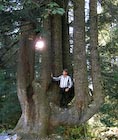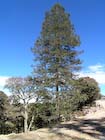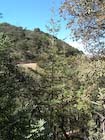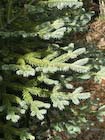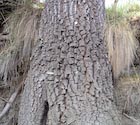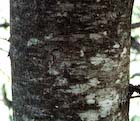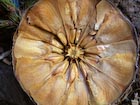Conservation Status

Abies religiosa
(Kunth) (Kunth) Schltdl. & Cham. (1830)
Common names
Sacred fir; oyamel [Nahuatl]; pinabete [Spanish].
Taxonomic notes
Type: Mexico, Guerrero, F. W. H. A. von Humboldt & A. J. A. Bonpland s.n. (holotype P). Synonymy: Pinus religiosa Kunth, Picea religiosa (Kunth) Loudon; see POWO for heterotypic synonyms. Note that A. vejarii var. mexicana is sometimes treated as a subspecies of A. religiosa (Strandby et al. 2009).
Phylogenetics of the Mexican and Mesoamerican firs is a very long-standing problem that, even with molecular methods, still has not been sorted out. There is general agreement that they all belong to Abies section Grandis, and they have diverged over quite a long period of time, approximately the past 55 million years (Aguirre-Planter et al. 2012; Xiang et al. 2015, 2018). At least 20 taxa have been described at species rank, with many more subspecies and varieties. I currently find 9 species (A. concolor, A. durangensis, A. flinckii, A. guatemalensis, A. hickelii, A. hidalgensis, A. jaliscana, A. religiosa, A. vejarii). All of the currently-recognized species have now been established as distinct using independent lines of morphological and molecular evidence.
There is still uncertainty and debate regarding the "A. religiosa complex". A detailed morphological study by Strandby et al. (2009) provides a strong argument for reducing A. guatemalensis, A. hickelii and A. vejarii to infraspecific taxa of A. religiosa. This morphological study conflicts with a molecular study of the southern Mexican firs, Abies flinckii, A. guatemalensis, A. hickelii, and A. religiosa, which found that they all have low genetic diversity within populations, suggesting that they have each experienced genetic bottlenecks during their retreat to their current interglacial refugia (a biogeographic situation which also puts them at extreme risk from global warming). There was, however, high diversity between populations, supporting their treatment as separate taxa (Aguirre-Planter et al. 2000). Indeed, A. flinckii and A. religiosa are sufficiently distinct to enable a detailed evaluation of the two and to conclude, as Cruz-Nicolás et al. (2020) argue, that "Abies religiosa and A. flinckii are two distinct, ancient species that have recently come into contact" (a finding consistent with that of Aguirre-Planter et al. 2012). A later molecular study considering all of the 9 species except A. jaliscana provided strong support for A. concolor and A. guatemalensis together in a clade sister to the other 7 species, but relationships between those 7 varied with the analysis method (Xiang et al. 2024). Another study that did include A. jaliscana indicates that A. flinckii and A. jaliscana are sister species (Semerikova et al. 2018). Moreover all of these taxa are likely capable of hybridizing and over the course of multiple Pleistocene glacial and interglacial cycles many of them have had the opportunity to do so. Thus each population of each of these species is to some degree unique; it will be long before the differences are well understood.
Description
Trees to 40(-60) m tall and 200 cm dbh with a single, straight, round trunk and a pyramidal or conical crown. First-order branches long, slender, ascending, later becoming horizontal to pendant. Bark smooth, gray-white, becoming dark grey-brown, deeply fissured, breaking into small plates. Branchlets slender, red-brown to purple-red, irregularly grooved, glabrous or slightly pubescent, with circular leaf scars. Leaves spirally arranged, pectinate, slightly assurgent, (11-)24-26(-72) × 1.2-1.6 mm, linear, twisted at base, grooved above (groove ca. 10% of leaf thickness), stomata only on underside, in two white bands separated by a midrib; upper surface shiny dark green, lower surface lighter with whitish stomatal bands; 2 smallish marginal resin canals. Pollen cones lateral, ±pendulous, 10-15 mm long with red microsporophylls. Seed cones erect, lateral(-subterminal) on a short, often curved peduncle, ovoid-oblong to cylindrical, sometimes curved, obtuse, (5-)9-10(-15) × 4-6 cm, the 19-20 mm long bracts exserted or not, color violet-blue with yellow bracts, darkening with age to a purple-brown with brown bracts; rachis persistent, dark brown. Seed scales cuneate, a mid-cone measuring 2-3 × 3-3.5 cm, smooth, puberulent, outer margin rounded, entire. Bract scales spathulate, tapering, 3-3.5 cm long, exserted, reflexed. Seeds 10 × 5 mm, shiny brown with a cuneate brown wing 10-15 mm long (Farjon 1990, Strandby et al. 2009). See García Esteban et al. (2004) for a detailed characterization of the wood anatomy.
Distribution and Ecology
W Guatemala; Mexico: S Chihuahua, Colima, Guerrero, Jalisco, C Michoacán, Mé, S Nuevo León, Oaxaca, Puebla, San Luis Potosí, Sinaloa, W Tamaulipas, Tlaxcala, Veracruz. It occurs at (1200-)2100-3100(-4100) m elevation on well-drained mountain soils. Associated species vary with its wide latitudinal range but often include Pseudotsuga menziesii subsp. glauca, Pinus montezumae, and Pinus hartwegii (Farjon 1990). Hardy to Zone 8 (cold hardiness limit between -12.1°C and -6.7°C) (Bannister and Neuner 2001).
Remarkable Specimens
Traveling in Mexico, I have seen a number of trees exceeding 40 m in height and 150 cm diameter, but heights to 60 m and diameters to 200 cm are reported by Farjon (1990) without specifics, and Chris Hood (e-mail 2022.04.19) sent me a photo with a tree near Parque Nacional El Malinche, on the Puebla-Tlaxcala border, that is in the 200-250 cm dbh class. He reports a number of trees in that area of comparable size. The multi-trunked specimen shown at right, growing at Nevado de Colima, is easily the largest tree I know of with regard to total wood volume.
A fire history study mentions a crossdated 107-year-old tree (Cerano-Paredes et al. 2021), but their Figure 3 indicates the oldest tree sampled was 113 years. A study of stand age structure variation with elevation found ages of up to 106 years, based on crossdated increment cores, which included pith and were taken as close to ground level as possible (Sáenz-Ceja and Pérez-Salicrup 2020). This age is implausibly young, given the size these trees attain; further study will certainly yield greater age estimates.
Ethnobotany
The species' name refers to its widespread use in Mexico to create decorations for use at religious festivals, especially Christmas. See the Remarks section for information on its value as a source of timber and in ecotourism.
Dendrochronological usefulness is explored by Huante et al. (1991), who examine climate-tree growth relationships and develop a crossdated chronology. A dendrochemistry study in the forest park, Desierto de Los Leones, west of Mexico City, found elevated lead and cadmium levels beginning in the 1960s, which Watmough and Hutchinson (1998) attributed to urbanization and increasing use of motor vehicles in the Valley of Mexico. Bernal-Salazar et al. (2004) used ring widths to characterize the history of air pollution impacts on trees in the same area, finding evidence of effects caused by air pollution as early as the 1970's, well before researchers reported effects on tree foliage.
Observations
It can be readily seen east of Mexico City on the high road to Puebla, which goes east out of Amecameca at about 19.08° N, 98.69° W. This area is popularly called the "forest of Christmas trees." It is also readily seen low down on the road up Nevado de Toluca (about 19.03° N, 99.80° W), where some trees are nearly 40 m tall. Some fine large trees are easily accessible near the forest camp on Nevado de Colima at about 19.6° N, 103.6° W. Finally, it may be found growing with A. vejarii and a large collection of other conifers on Cerro Potosí at about 24.9° N, 100.2° W. See the remarks below for some other locations.
Remarks
Stands of Abies religiosa provide winter habitat for the Monarch butterfly. A Project Lighthawk documentary provides a useful summary HERE (or, en Español). These stands are being depleted by logging, threatening the continued survival of the butterfly. As of 2007, the logging continues even though much of the area involved has been protected (as detailed in the preceding link), and the phenomenon has become such a popular ecotourism attraction that it provides a significant income to communities near these forests. Some of the most popular reserves are near the town of Angangueo, and a variety of tours are available to visit them.
A. religiosa has experienced severe declines in forests near Mexico City due to foliar injury and reduced needle retention caused by air pollution (Terrazas and Bernal-Salazar 2002).
Pests afflicting this species include the sacred fir looper (Lepidoptera: Evita hyalinaria), a defoliator; and the dwarf mistletoe Arceuthobium abietis-religiosae (Hawksworth et al. 1996). Fungal pathogens include Heterobasidion annosum, a root rot widely distributed in northern hemisphere conifers (Scharpf 1993). Abies religiosa also supports the morel mushroom, Morchella esculenta (Pilz et al. 2007). Yum.
Citations
Aguirre-Planter, Érika, Glenn R. Furnier, and Luis E. Eguiarte. 2000. Low levels of genetic variation within and high levels of genetic differentiation among populations of species of Abies from southern Mexico and Guatemala. American Journal of Botany 87:362-371.
Aguirre-Planter, Érika, Juan P. Jaramillo-Correa, Sandra Gómez-Acevedo, Damase P. Khasa, Jean Bousquet, and Luis E. Eguiarte. 2012. Phylogeny, diversification rates and species boundaries of Mesoamerican firs (Abies, Pinaceae) in a genus-wide context. Molecular Phylogenetics and Evolution 62(1):263-274.
Bernal-Salazar, S., T. Terrazas and D. Alvarado. 2004. Impact of air pollution on ring width and tracheid dimensions in Abies religiosa in the Mexico City basin. IAWA Journal 25(2): 205-215. Available: http://bio.kuleuven.be/sys/iawa/PDF/IAWA J 21-25/25 (2) 2004/25(2) 205-215.pdf (accessed 2008.06.15).
Cerano-Paredes, Julián, Dante A. Rodríguez-Trejo, José M. Iniguez, Rosalinda Cervantes-Martínez, José Villanueva-Díaz, and Osvaldo Franco-Ramos. 2021. Fire History (1896–2013) in an Abies religiosa Forest in the Sierra Norte of Puebla, Mexico. Forests 12(6):700.
Cruz-Nicolás, Jorge, Gustavo Giles-Pérez, Eréndira González-Linares, Julia Múgica-Gallart, Andrés Lira-Noriega, David S Gernandt, Luis E Eguiarte, and Juan P Jaramillo-Correa. 2020. Contrasting evolutionary processes drive morphological and genetic differentiation in a subtropical fir (Abies, Pinaceae) species complex. Botanical Journal of the Linnean Society 192:401–20. https://doi.org/10.1093/botlinnean/boz077.
Farjon, Aljos. 1990. Pinaceae: drawings and descriptions of the genera Abies, Cedrus, Pseudolarix, Keteleeria, Nothotsuga, Tsuga, Cathaya, Pseudotsuga, Larix and Picea. Königstein: Koeltz Scientific Books.
Huante, P., E. Rincon, and T. W. Swetnam. 1991. Dendrochronology of Abies religiosa in Michoacan, Mexico. Tree-Ring Bulletin 51:15-28.
Pilz, D., R. McLain, S. Alexander, L. Villarreal-Ruiz, S. Berch, T.L. Wurtz, C.G. Parks, E. McFarlane, B. Baker, R. Molina, and J.E. Smith. 2007. Ecology and Management of Morels Harvested From the Forests of Western North America. USFS Pacific Northwest Research Station, General Technical Report PNW-GTR-270.
Schlechtendahl, D. and L. Chamisso. 1830. Linnaea 5: 77. Available: Biodiversity Heritage Library, accessed 2025.01.21.
Sáenz-Ceja, Jesús Eduardo, and Diego Rafel Pérez-Salicrup. 2020. Modification of fire regimes inferred from the age structure of two conifer species in a tropical montane forest, Mexico. Forests 11:1193.
Strandby, U., K.I. Christensen, and M. Sørensen. 2009. A morphometric study of the Abies religiosa–hickelii–guatemalensis complex (Pinaceae) in Guatemala and Mexico. Plant Systematics and Evolution 280:59-76.
Terrazas, T. and S. Bernal-Salazar. 2002. Histological symptoms of air pollution injury in foliage, bark and xylem of Abies religiosa in the Basin of Mexico. Pp. 261-282 in M.E. Fenn et al. (eds.), Urban Air Pollution and Forests: Resources at Risk in the Mexico City Air Basin. Ecological Studies 156. Springer-Verlag.
Watmough, S.A. and T.C. Hutchinson. 1998. Change in the dendrochemistry of sacred fir close to Mexico City over the past 100 years. Environmental Pollution 104(1): 79-88.
Xiang, Qiaoping, Jie Yang, David S. Gernandt, et al. 2024. Ecological and evolutionary factors contribute to the uneven diversification of firs in the northern hemisphere. Journal of Biogeography jbi.15055. https://doi.org/10.1111/jbi.15055.
See also
Elwes and Henry 1906-1913 at the Biodiversity Heritage Library (Photo). This series of volumes, privately printed, provides some of the most engaging descriptions of conifers ever published. Although they only treat species cultivated in the U.K. and Ireland, and the taxonomy is a bit dated, still these accounts are thorough, treating such topics as species description, range, varieties, exceptionally old or tall specimens, remarkable trees, and cultivation. Despite being over a century old, they are generally accurate, and are illustrated with some remarkable photographs and lithographs.
Liu 1971.
